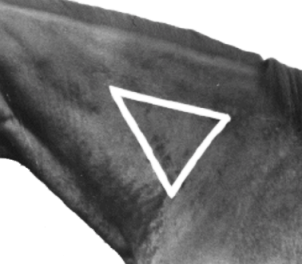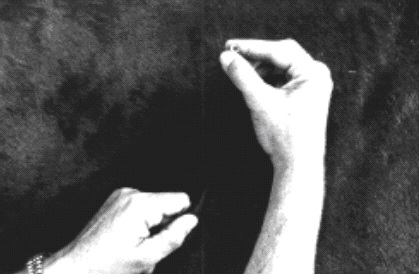Giving Your Horse Intramuscular Injections
"Giving your horse a shot is not difficult to learn."
A favored horse injection site is the neck
Horse owners on occasion may be required to give their horse vaccines that are administered through an injection, such as protecting your horse from the West Nile virus. Giving horse injections is not difficult to learn and is necessary at times for maintaining your horse's health.
Basic types of horse injections include:
- Intravenous injections administered into a vein
- Intradermal injections administered into the skin
- Subcutaneous injections administered underneath the skin
- Intramuscular (IM) injections administered into a large muscle mass
Intravenous injections should only be given by your veterinarian, unless you have had training. Intramuscular injections are the most common type and are given to adult horses with a needle long enough so the medication is injected deep into the muscle mass. Most horses will allow you to safely and efficiently give an Intramuscular shot without any objection.
Giving an Intramuscular shot to a horse is routine, but is not without risk. Determining what type of medication and dosage your horse needs and how it is to be administered should be determined by your veterinarian. Discuss with your veterinarian what signs of drug reaction to expect in your horse and how to handle any adverse drug reactions. Improper drug handling and injection technique can result in infections such as needle abscesses, life-threatening drug reactions from allergic shock, or ineffective drugs or vaccines. After administering any shots, collect the used needles with their plastic covers attached, and syringes in a resealable plastic bag or bottle and take them to your veterinarian's office for proper disposal.
Horse Injection Site Preparation
Antiseptic cleaning of the injection site is not common practice for most horse owners or veterinarians. Studies have shown alcohol is a weak antiseptic having very little effect on the cleanliness of the injection site. To thoroughly clean an injection site, the horse's hair must be shaved, the area scrubbed with an antiseptic soap which must remain in contact with the skin for a few minutes and then rinsed with alcohol.
Simply brushing any noticeable dirt from the injection area first and then inserting the needle into dry skin is the method used by many horse owners and veterinarians. There is no noticeable increase in infection with this method. Using a sterile needle and syringe is more important in preventing injection site infections than thoroughly cleaning the site.
Horse Handling
Always have a handler when giving your horse an injection. Do not tie the horse, but rather have the handler hold the lead line. The handler and person giving the shot should be on the same side. If the horse pulls while administering the shot, move with the horse and continue the injection when it calms down. If the horse tries to kick, the horse's head should be pulled toward the handler - this makes the horse swing its rear-end away from you.
Base of the Neck - Horse Injection Site
 The base of the horse's neck is a favored injection site as it allows you to remain in a relatively safe area by the horse's shoulder.
The base of the horse's neck is a favored injection site as it allows you to remain in a relatively safe area by the horse's shoulder.
To locate the injection area, place the heel of your hand on the base of the horse's neck where it joins the shoulder, about midway between the crest and the bottom of the neck. The area covered by your palm is the injection site.
Too high toward the crest you risk hitting ligaments, and too low toward the bottom of the neck you may hit bone or a vein. Stay near the base of the neck rather than injecting higher up the neck toward the ears to avoid ligaments, bone, and blood vessels and to give a larger muscle mass for the injection. Keeping near the base of neck also helps to prevent muscular soreness.
Intramuscular Horse Injection Procedure
The general procedure for an Intramuscular injection is:
- remove the needle from the syringe
- insert the needle into the muscle
- attach the syringe
- aspirate
- slowly insert the medication
There are a few basic rules to follow when giving your horse an Intramuscular injection.
- Insert the needle in a perpendicular fashion. Do not slant the needle upward or downward. Sink the needle into the muscle all the way to the hub where it attaches to the syringe to ensure the needle will not shift during the injection and that it is deep into the muscle mass.
- Insert the needle quickly and decisively. A fast stab is easier for you and less painful to the horse than inserting the needle slowly into the skin.

A quiet horse will allow you to simply pop the needle into its neck. However, if the horse needs a little distraction from the needle stick, one good method is to pinch up the horse's skin next to the injection site for a few seconds prior to inserting the needle. Then while holding the pinched skin, insert the needle next to the pinched area.
Another distraction method is to hold the needle between the thumb and forefinger. Tap the horse vigorously about 3 times with the side of your palm in the injection site and without breaking rhythm, rotate your hand and insert the needle. A similar method is rubbing against the direction of the horse's hair growth several times while holding the needle between the thumb and forefinger. Insert the needle on the last rub.
- Attach the syringe and slightly pull back on the plunger (aspirate) before injecting the medication to ensure you are not in a blood vessel. Some commonly used drugs can kill a horse if accidentally injected into the blood stream.
If blood collects at the hub of the needle after it's been inserted or blood is drawn when pulling back the plunger, then you will need to pull the needle out and redirect it before giving the injection.
It is safest to pull the needle out completely and start over in a different area with a clean needle. However, if you have a needle shy horse, you can pull the needle partially out of the skin, change the injection angle, and push it back into the muscle. Needle shy horses object to the needle going through the skin, which is the painful part, and will be relatively quiet after the needle is through the skin. Remember to aspirate again when using a clean needle or redirecting a needle to make sure you are not in a blood vessel.
- Slowly inject the medication. Novice horse owners often worry about injecting air into the horse when the needle is inserted first without the syringe attached. However this amount of air injected into the horse is minor and will not harm it.
Be prepared for an adverse drug reaction. An anaphylactic shock usually occurs rapidly and the horse can die within minutes. Discuss signs and proper treatment of anaphylactic shock with your veterinarian before-hand. He may give you epinephrine to be administered in case of anaphylactic reactions. Be sure you have the epinephrine on hand before you give your horse an injection. If you have to leave and go somewhere to get the epinephrine, the horse may die before you can get back to administer the epinephrine.
Observe the horse for any signs of allergic reaction for about 30 minutes after giving an injection. Usual signs of allergic reactions such as swelling around the injection site, hives, increased respiratory rate, depression, or agitation indicate the horse may be allergic to the medication. Discontinue its use and consult your veterinarian immediately.




